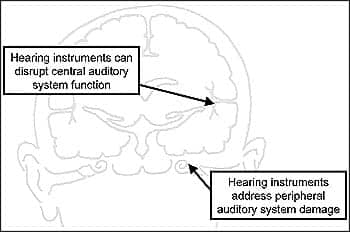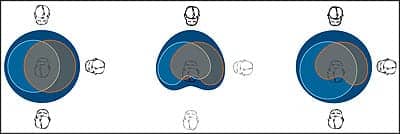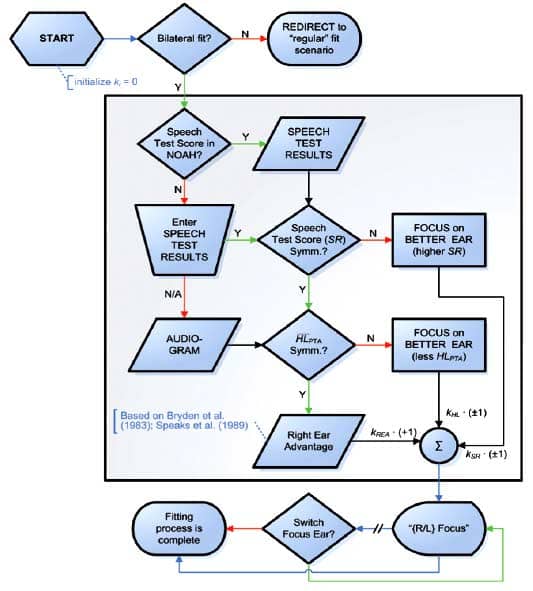The leading complaint of hearing instrument wearers has been, and continues to be, understanding speech in noise. Only 30% of hearing instrument wearers in the United States are satisfied with the performance of their hearing aids in noise,1 and this is a primary reason for not wearing them.2
Not surprisingly, better speech intelligibility in noise is an improvement sought by 95% of hearing instrument users in the United States and 87% of those in Germany.3 From this data, it seems reasonable to conclude that, if speech understanding is improved, then people will more readily acquire and successfully wear hearing instruments. Yet, these same studies indicate that satisfaction with hearing instruments over the previous 10 years—a period marking the transition from analog to advanced digital hearing instrument technology—is virtually unchanged.1
In examining survey results of hearing instrument wearers, it is important to consider that an individual’s responses to a questionnaire do not entirely capture what led to a particular response. For example, respondents to the MarkeTrak surveys are asked to rate satisfaction with varying hearing aid features, including “Use in noisy situations.” It is a clear and consistent finding that hearing instrument users have issues with “Use in noisy situations.” However, two individuals responding to that item might have very different issues. For one person, it may mean “How well do you understand speech in noisy situations?” To another, it may mean “Can you stand to keep your hearing aids on in noisy situations?”
The relative importance of hearing instrument performance in noisy situations also differs among individual respondents, which also might affect their satisfaction ratings. Investigators have yet to establish a link between speech understanding in noise performance and successful hearing instrument use.4,5
Is Directionality the Solution?
Throughout the history of hearing instrument research and development, efforts have focused on compensating for the damage of the peripheral auditory system—damage that often results in reduced speech recognition capability, particularly in the presence of competing sounds. The use of directional microphones has consistently been shown to markedly improve SNR—and thus speech recognition performance—in numerous laboratory investigations,6-10 with reported directional benefit ranging from 3.27 dB9 to 8.5 dB.7
Such dramatic SNR improvements might indicate that the hearing-in-noise challenges of hearing instrument users have been solved by directional microphones. Most hearing instruments with directionality provide wearers the ability to switch to an omnidirectional mode. This is useful when the signal of interest is not in front of the wearer. As discussed earlier, however, improved speech intelligibility in noise is not a guarantee of successful hearing aid use. Cord et al11 pursued this specific avenue of investigation in terms of directional benefit, but did not find that an individual’s success with directionality in everyday life could be predicted by measured directional benefit in the laboratory.
Another reason that directional microphone technology in and of itself does not ensure satisfied and successful hearing instrument use is related to the extent of directional benefit in daily life. Studies as early as Nielsen’s6 in the early 1970s have failed to establish the same striking benefits of directionality in real-life situations as are observed under controlled laboratory conditions.
One reason for this discrepancy is that the physical characteristics of the environment significantly affect directional benefit. Directional benefit is greatest in an anechoic environment and decreases as reverberation increases.12-14 Other factors related to the physical environment include location of the competing noise, separation of the signal and noise, and distance to the signal.15
In addition to the acoustic aspects mentioned above, Walden et al10 suggested numerous individual factors that could account for the inconsistency they observed between the significant directional benefit measured under laboratory conditions and the nonsignificant subjective ratings of directionality over omnidirectionality in everyday situations. For example, test participants may not have learned to use the directionality feature during the trial period. Appropriate use of selectable directionality requires that users analyze and recognize situations in which directionality would be beneficial, that they know how to activate it, that they can and do make the change, and even that they are able to manipulate their surroundings to maximize the directional advantage.
Additionally, for the feature to be beneficial, wearers must encounter real-life situations in which they could benefit from directionality. Consider an individual who wears his hearing aid only in situations with very favorable signal-to-noise ratios. It is unlikely he will perceive any benefit of switching to a directional response. Further, directionality has the potential to interfere with his ability to maintain awareness of the listening environment or to shift his attention to other sound sources in the environment.
Based on this discussion, it should come as no surprise that many hearing instrument wearers fit with selectable directionality do not make use of this feature. Cord et al16 interviewed 112 patients who had been fit with a directional aid at least 6 months prior. They found that more than one-third of them did not switch between the omnidirectional and directional microphone modes. Reasons for not switching included not understanding when to switch to directionality; not experiencing the benefit of this feature in difficult listening environments; and difficulty in operating the switch to change microphone modes. The participants in this study who did change microphone configuration spent about one-quarter of the time listening with a directional response.
Test subjects further described situations in which directionality was most helpful as those where noise was present, and the signal of interest was in front and relatively near to them. The influence of these physical characteristics in determining microphone preference was corroborated by Surr et al,17 who fit 11 individuals with selectable directional hearing instruments and asked them to keep detailed journals describing situations in which a particular microphone mode was preferred. In a follow-up study, Walden et al18 showed that adult hearing aid wearers spent most of their active listening time in challenging acoustic conditions and confirmed that microphone preference tends to be related to the physical characteristics of the environment. They suggested that “knowing only signal location and distance and whether background noise is present or absent, omnidirectional/ directional hearing aids can be set in the preferred mode in most everyday listening situations.”
An important technological implication is that hearing instruments that can accurately characterize the physical environment should also be able to select the preferred microphone mode.
Acoustic vs Auditory
Scene Analysis
Many hearing instrument manufacturers, including ReSound, have introduced devices that automatically switch microphone mode based on the physical characteristics of the environment. This is also referred to as acoustic scene analysis—decisions are based only on the acoustic surroundings without consideration of the individual’s signal of interest.
Manufacturers use a variety of techniques for acoustic scene analysis and do not employ the same criteria for switching from omnidirectional to directional modes. Automatic switching algorithms also differ in the speed of switching between modes. Although automatic switching of microphone mode is designed to make the lives of hearing instrument users easier, it can potentially become a source of frustration.
The intent of the wearer may not always be consistent with what is predicted based on the acoustic scene analysis. For example, at a party, a person can choose to listen to the individual at their side without turning their head. A hearing instrument that automatically switches to a directional response predicts what the wearer wants to hear based on an analysis of physical data and assumes that the signal of interest is in front of the listener. The signal processing does not have all the information necessary to accurately make this decision. It cannot actually know what the wearer wants to hear, and it cannot predict when wearers want to shift their attention to another sound source. A listener does not perform acoustic scene analysis, but rather auditory scene analysis.
Auditory scene analysis is the process by which the auditory system sorts and interprets the complex stream of acoustic information in natural environments. The acoustic energy from many sound sources and directions are mixed at the ears of listeners, who can use their sense of hearing to attend to them individually, to shift attention among the different sources, as well as to draw conclusions about the physical properties of each sound source.19 Auditory scene analysis is mediated by high-order auditory processes, and thus remains a capability of most hearing instrument wearers.
Hearing instruments compensate for peripheral effects, such as loss of audibility and dynamic compression, but do not take the entire auditory system into account. Hearing instrument signal processing strategies can potentially interfere with centrally mediated decisions. Consequently, while automatic microphone mode switching can provide the benefit of directionality to individuals who are not capable of selecting, or do not like to select, microphone mode, it can potentially work at odds with the wearer’s auditory scene analysis.
A New Fitting Approach
A novel and unorthodox idea for allowing hearing aid wearers directional benefit without requiring them to switch modes is by fitting the microphone directionality in an asymmetrical manner. This approach can also help avoid conflicts between acoustic and auditory scene analysis for devices with automatic switching. The benefit of asymmetric fitting is that the wearer is not required to manually switch the microphone mode and that one device would always be in a preferred microphone mode.
While an asymmetric fitting strategy such as this may seem counterintuitive, there is evidence that it can provide similar benefit to bilateral directionality while circumventing issues with manual and automatic switching. Bentler et al20 evaluated five different fitting strategies: binaural omnidirectional; binaural directional with three different polar responses; and asymmetric (defined as omnidirectional response on the left ear and hypercardioid directional on the right ear). In terms of measured directional benefit, no differences between the asymmetric and the bilateral directional fittings were reported. Both the asymmetric and bilateral directional fittings resulted in significantly better directional benefit than the bilateral omnidirectional fitting. In addition, subjective ratings of sound quality were similar for the asymmetric and bilateral symmetric fittings.

|
| FIGURE 1. Hearing instruments compensate for peripheral effects such as loss of audibility and reduced dynamic range. Some signal processing, such as automatic microphone mode switching, may interfere with the auditory scene analysis of the user. |
To further investigate subjective aspects of microphone mode preference, Whitmer et al21 asked listeners to indicate preference for a unilateral fitting, bilateral directional fitting, or asymmetrical directional fitting when listening to moderately loud and loud recorded speech-in-noise situations. Listeners also specified preferences based on clarity, comfort, or other factors. Clear differences in listening preference for microphone configuration were found based on analysis based on the listeners’ reasons for their preferences. When clarity was the deciding factor, the bilateral directional and asymmetric directional fittings were equally preferred, which is in agreement with the speech-in-noise testing results of Bentler et al.20
The advantage of an asymmetric fitting in terms of audibility of sounds coming from different directions is illustrated in Figure 2. The panel on the left represents a listener fit bilaterally with omnidirectional microphones. In this case, the speaker in the front as well as those off to the side and behind will be audible, but not necessarily intelligible. In the middle panel, the listener is fit bilaterally with directional microphones. For this configuration, the speaker in front will be audible and intelligible, but audibility for the other speakers will be reduced. Finally, the panel on the right shows an asymmetric microphone mode fitting. Since the directional benefit for this type of fitting is equivalent to the bilateral directional condition, both audibility and intelligibility are preserved for the speakers at all locations in this example.

|
| FIGURE 2. Speakers at different locations are audible with a bilateral omnidirectional fitting (left panel), but not necessarily intelligible. Bilateral directional microphone fittings decrease audibility for speakers beside and behind the listener (middle panel). With an asymmetric fitting (right panel), speakers from different directions are audible, and the listener can shift his attention to any one of them. |
Asymmetric fitting has also been evaluated in a field investigation. Cord et al22 applied an asymmetric strategy in fitting individuals who had not been successful with selectable directional hearing instruments. Like Bentler et al,20 no differences in directional benefit measured in the laboratory were found for asymmetric versus bilateral directional microphone configurations. However, both of these conditions yielded better performance than when the test condition was bilateral omnidirectional.
For the field evaluation, subjects kept track of the listening situations they encountered and rated their ease of listening in these situations. They were fit for part of the evaluation with a bilateral omnidirectional response and for part with an asymmetric fitting. The listening situations were assigned to one of two groups: those in which an omnidirectional response should be favored and those in which a directional response should be favored. Analysis of 1,612 subject logs of use situations revealed significantly higher ease of listening for the asymmetric condition than the bilateral omnidirectional condition in situations favoring a directional response. There was no difference in ease-of-listening ratings between the two conditions for situations favoring an omnidirectional response. These results are compelling evidence that not only does the directional benefit of an asymmetric fit extend to real-world situations, but it also can provide directional benefit to previously unsuccessful users of selectable directionality.
A New Bilateral Fitting Strategy
Natural Directionality describes a bilateral fitting strategy that relies on the superiority of the human auditory system’s cognitive signal processing rather than artificial decision-making by the hearing instrument. This approach delivers acoustic information differentially to the right and left ears to afford the user directional benefit without working against higher level auditory scene analysis.
When fitting Natural Directionality, a “focus” ear and “monitor” ear are carefully determined based on audiometric data. The focus ear is fit to automatically adapt the microphone mode to the most favored based on the acoustic scene; the monitor ear is fit with an omnidirectional response, allowing the wearer to remain oriented in the environment. The specific inputs to the two ears do not disrupt the wearer’s cognitive analysis of the simultaneous stream of sounds that make up any real-life situation. Thus, the acoustic information made available to the central auditory system enables the listener to efficiently use his sense of hearing to understand the properties of sound-producing events.
An overview of the literature on microphone preferences and asymmetrical microphone fittings supports that the Natural Directionality strategy is the configuration that provides the greatest overall benefit when audibility, speech intelligibility and ease of listening are considered (Figure 3). For audibility, any bilateral directional approach will result in the signal of interest sometimes not being heard. Since the signal of interest is off-axis (not in front of the listener) 20% of the time,18 this is a frequent scenario for a hearing instrument wearer.

|
| FIGURE 3. Literature on microphone mode preferences and asymmetrical microphone fittings supports that Natural Directionality offers the most extensive benefit in terms of audibility, speech intelligibility, and ease of listening. |
Natural Directionality maintains audibility for off-axis signals via the monitor ear. For intelligibility, it has been demonstrated that an asymmetrical approach such as Natural Directionality provides equivalent directional benefit to bilateral directionality. Manually selectable directionality depends on the user recognizing appropriate situations and switching microphone mode. Finally, ease of listening in actual use has been shown to be significantly better for the Natural Directionality approach than for other microphone configurations in challenging listening situations.
The ReSound Aventa fitting software incorporates a “calculator,” which automatically suggests which ear should be fit as the focus ear and which one as the monitor ear. The information used to determine the monitor and focus ears is primarily speech recognition scores and, should that not be available, hearing threshold levels. Individuals with bilateral hearing impairment demonstrate interaural differences in SNR loss even when their hearing losses are symmetrical. Furthermore, their binaural performance is determined by the ear with the least SNR loss.23

|
| FIGURE 4. The Focus-ear calculator determines the fitting configuration for Natural Directionality. |
If speech audiometry data is available in NOAH and indicates a significant interaural performance difference, then the better ear will be selected as the focus ear. The fitter may also enter speech audiometry results directly in the ReSound Aventa fitting software. In the event that speech recognition scores are not entered, the better-hearing ear will be selected for asymmetric hearing losses, and the right ear for symmetric losses. For symmetric losses, the right ear is selected as focus ear based on the knowledge that most individuals have a right ear advantage when listening to verbal input.24
In terms of signal processing, Natural Directionality incorporates a new directional algorithm that combines an invariable directivity pattern with more sophisticated directional processing. This special processing is a critical and unique element of the system. While other directional systems can be fit asymmetrically, the ReSound Azure’s distinctive directionality is designed to maintain constant focus yet ensures natural balance in volume and sound quality between the two ears. There are three factors that make this possible:
1) The directional processing accounts for head and torso sound reflections to ensure optimum directional characteristics in situ. This ensures that the directivity achieved when the device is worn on the head is equivalent to what can be measured in a laboratory setup.

|
| Myths About Hearing in Noise and Directional Microphones, by Mead C. Killion, PhD. February 2004 HR Archives. Interpreting the Directivity Index by Andrew Dittberner, PhD, and Ruth Bentler, PhD. June 2003 HR Archives. |
2) The low-frequency response for the focus ear is equalized with the response for the monitor ear as part of the directional processing. Other directional systems equalize the low frequency roll-off inherent to directional processing by adding gain in the compressor, which has the effect of adding noise. If applied to an asymmetric fitting strategy, the perceptual effect of this traditional approach to low frequency equalization would result in the focus ear sounding noisier than the monitor ear, particularly in quiet situations.
3) Proximity effects—another drawback of directional microphones—are eliminated as part of the ReSound Azure’s directional processing. This means that the loud or boomy quality of nearfield sounds such as the wearer’s own voice and wind noise is avoided.
Based on the results of Walden et al,18 directionality has shown to be favored in the presence of background noise when a speaker is located in front of and fairly near the listener. However, hearing instrument wearers are only in this type of listening situation about one-quarter of their total hearing instrument usage time.22
The asymmetric application of ReSound Azure’s focused directionality ensures that one of the hearing instruments will always be in the preferred microphone mode, thus eliminating disruption of the wearer’s auditory scene analysis. In other words, the wearer is provided directional benefit, but is enabled to shift attention without interference of the hearing aid sound processing.
References
- Kochkin S. MarkeTrak VI: 10-year customer satisfaction trends in the US hearing instrument market. Hearing Review. 2002;9(10):14-25,46.
- Kochkin S. MarkeTrak V: Why my hearing aids are in the drawer: the consumer’s perspective. Hear Jour. 2000;53(2):34-42.
- Kochkin S. MarkeTrak VI: Consumers rate improvements sought in hearing instruments. Hearing Review. 2002;9(11):18-22.
- Humes LE, Halling D, Coughlin M. Reliability and stability of various hearing-aid outcome measures in a group of elderly hearing aid wearers. J Speech Hear Res. 1996;39:923-935.
- Bentler RA, Neibuhr JP, Getta CV, Anderson CV. Longitudinal study of hearing aid effectiveness. II: Subjective measures. J Speech Hear Res. 1993;36:820-831.
- Nielsen HB. A comparison between hearing aids with directional microphone listeners. Scand Audiol. 1973;2:45-48.
- Valente M, Fabry D, Potts L. Recognition of speech in noise with hearing aids using dual microphones. J Am Acad Audiol. 1995;6:440-449.
- Wouters J, Litiere L, van Wieringen A. Speech intelligibility in noisy environments with one- and two-microphone hearing aids. Audiology. 1999;38:91-98.
- Pumford JM, Seewald RC, Scollie SD, Jenstad LM. Speech recognition with in-the-ear and behind-the-ear dual-microphone hearing instruments. J Am Acad Audiol. 2000;11(1):23-35.
- Walden BE, Surr RK, Cord MT, Edwards BE, Olson L. Comparison of benefits provided by different hearing aid technologies. J Am Acad Audiol. 2000;11:540-560.
- Cord MT, Surr RK, Walden BE, Dyrlund O. Relationship between laboratory measures of directional advantage and everyday success with directional microphone hearing aids. J Am Acad Audiol. 2004;15:353-364.
- Madison T, Hawkins D. The signal-to-noise ratio advantage of directional microphones. Hearing Instrum. 1983;34(2):18, 49.
- Hawkins D, Yacullo W. Signal-to-noise advantage of binaural hearing aids and directional microphones under different levels of reverberation. J Speech Hear Disord. 1984;49:279-286.
- Hornsby BWY, Ricketts T. Benefits of bilateral use of directional microphones. Paper presented at: American Auditory Society Annual Meeting, Scottsdale, Ariz; 2005.
- Amlani AM. Efficacy of directional microphone hearing aids: a meta-analytic perspective. J Am Acad Audiol. 2001;12:202-214.
- Cord MT, Surr RK, Walden BE, Olson L. Performance of directional microphone hearing aids in everyday life. J Am Acad Audiol. 2002;13:295-307.
- Surr RK, Walden BE, Cord MT, Olson L. Influence of environmental factors on hearing aid microphone preference. J Am Acad Audiol. 2002;6:308-322.
- Walden BE, Surr RK, Cord MT, Dyrlund O. Predicting hearing aid microphone preference in everyday listening. J Am Acad Audiol. 2004;15:365-396.
- Bregman AS. Auditory Scene Analysis: The Perceptual Organization of Sound. Cambridge, Mass; MIT Press; 1990.
- Bentler RA, Egge JLM, Tubbs JL, Dittberner AB, Flamme GA. Quantification of directional benefit across different polar response patterns. J Am Acad Audiol. 2004;15:649-659.
- Whitmer WM, Dittberner AB, Coughlin M, Dominguez M. The efficacy of an asymmetrical directional microphone fitting. Poster presented at: International Hearing Aid Research Conference: Lake Tahoe, Calif; 2006.
- Cord MT, Walden BE, Surr RK, Dittberner AB. Field evaluation of an asymmetric directional microphone fitting. J Am Acad Audiol. 2007;18:245-256.
- Walden T, Walden BE. Unilateral versus bilateral amplification for adults with impaired hearing. J Am Acad Audiol. 2005;16:574-584.
- Bryden M. Laterality: Functional Asymmetry in the Intact Brain. New York: Academic Press;1982.




